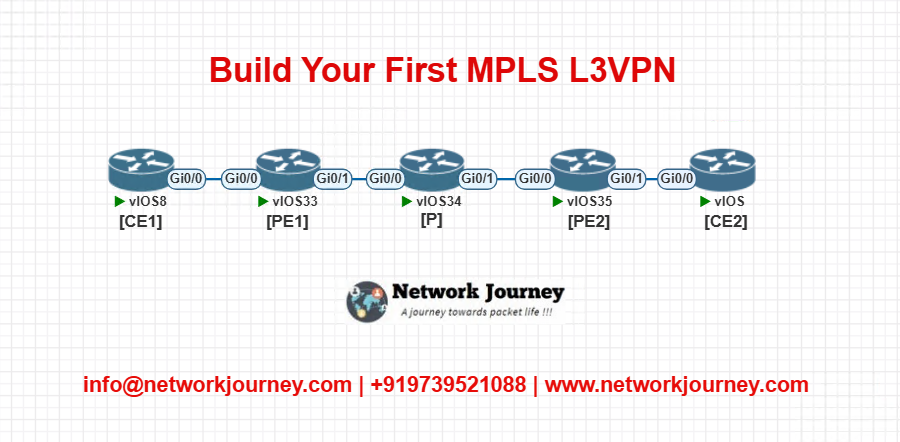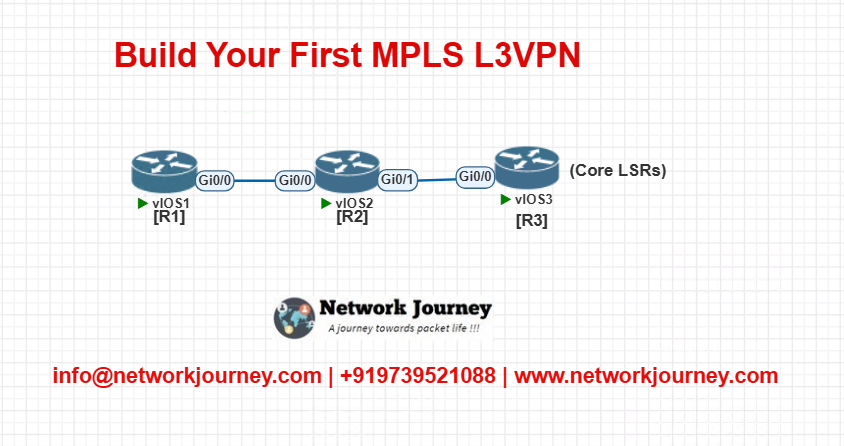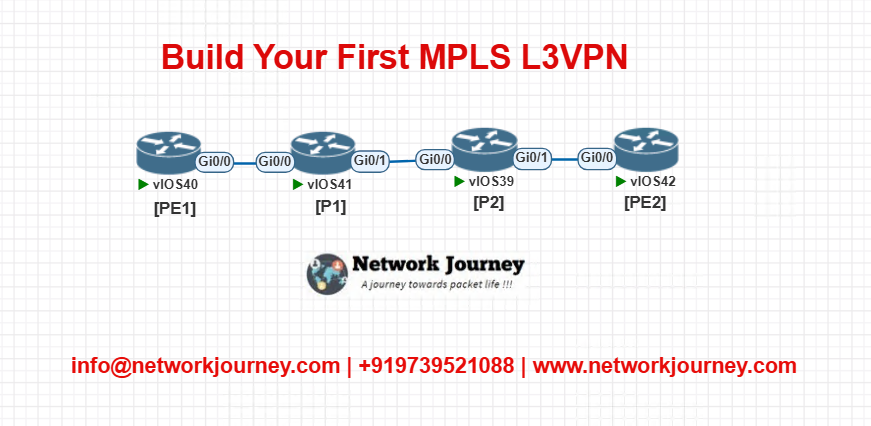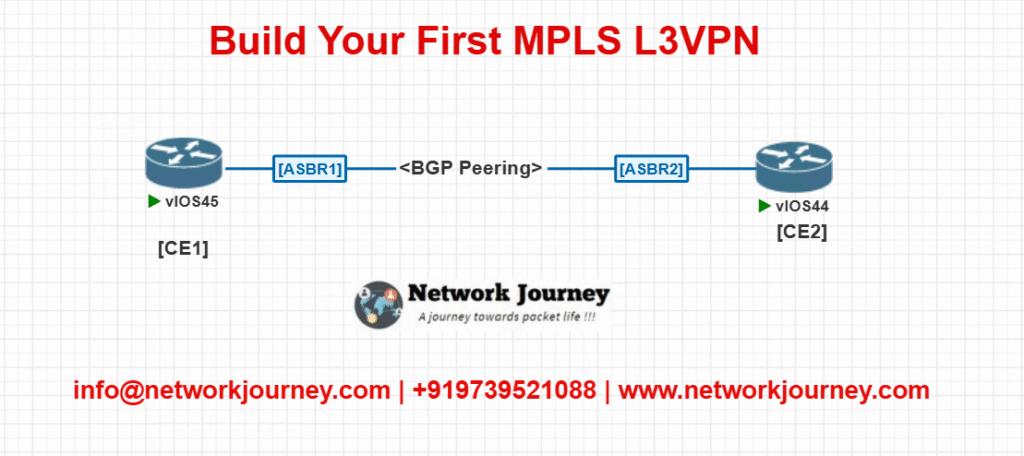Build Your First MPLS L3VPN: CLI + Diagrams + Troubleshooting [CCNP ENTERPRISE]
I want to walk you through a key topic that continues to dominate enterprise networks and is highly relevant for those preparing for advanced routing certifications: MPLS (Multiprotocol Label Switching).
Whether you’re preparing for your certification journey or working in a service provider role, understanding MPLS basics is a must. We’ll go beyond just the theory and get hands-on with CLI commands, real-world EVE-NG labs, and troubleshooting methods that mirror what you’ll encounter in real deployments.
Table of Contents
Theory in Brief: What is MPLS and Why It Matters
MPLS in Simple Terms
MPLS is a high-performance routing technique that forwards packets based on labels instead of traditional IP addresses. This makes forwarding faster and enables complex network services like L3VPNs, traffic engineering, and QoS policies.
Where It Fits in Network Design
Advanced certifications cover MPLS basics, LDP (Label Distribution Protocol), and L3VPN setup. These are not just theoretical topics—you may encounter CLI config and verification tasks that require practical understanding.
The Power of Label Switching
Traditional IP routing checks the destination IP at each hop. With MPLS, once the label is applied, routers (LSRs) forward packets based on that label, not the full IP lookup, enabling lower latency and predictable paths.
Real Use Cases in Enterprise
- Interconnecting remote sites over provider backbone
- Segmenting customer traffic
- Building scalable VPNs for large networks
MPLS Core Concepts
| MPLS Term | Description | Relevance in Networking |
|---|---|---|
| LSR | Label Switch Router | Core MPLS router |
| LDP | Label Distribution Protocol | Used to exchange labels |
| LIB | Label Information Base | MPLS label table |
| VRF | Virtual Routing and Forwarding | Required for MPLS L3VPN |
| PE/CE Routers | Provider/Customer Edge devices | MPLS edge configuration |
| RD/RT | Route Distinguisher/Target | Used to separate VRFs |
Pros and Cons of MPLS
| Pros | Cons |
| Fast label-based forwarding | Complex configuration for beginners |
| Supports scalable VPN solutions | Requires routing protocol integration |
| Predictable performance with QoS | Troubleshooting can be layered |
| Widely used in ISPs and enterprises | Some features are license-dependent |
CLI Commands
| Purpose | IOS Command | Description |
| Verify MPLS is enabled | show mpls interfaces | Check if MPLS is active on interfaces |
| View LDP neighbors | show mpls ldp neighbor | Verify LDP session |
| MPLS forwarding table | show mpls forwarding-table | See label bindings |
| VPNv4 BGP table | show bgp vpnv4 unicast all | View advertised VPN routes |
| VRF-specific route table | show ip route vrf <name> | Check customer-specific routing |
| Ping from VRF | ping vrf <name> <ip> | Validate reachability inside VRF |
Real-World Use Cases
| Use Case | MPLS Role | Why It Matters |
| ISP or provider backbone | Label switching, QoS | Ensures WAN scaling |
| Enterprise WAN segmentation | VRFs, RD/RT, L3VPN | Enables isolation |
| Customer-specific VPN routing | MPLS L3VPN | Real-world scenario |
EVE-NG Lab Topology 1: Basic MPLS L3VPN
Diagram

Objective:
Build a basic MPLS L3VPN to enable communication between CE1 and CE2 across provider MPLS core.
Sample Config (PE1):
ip vrf CUSTOMER1 rd 1:1 route-target export 1:1 route-target import 1:1 interface Gig0/0 ip vrf forwarding CUSTOMER1 ip address 10.1.1.1 255.255.255.0 router ospf 1 vrf CUSTOMER1 network 10.1.1.0 0.0.0.255 area 0
Do similar on PE2 and enable MPLS on core links.
EVE-NG Lab Topology 2: LDP and Label Propagation
Diagram

Objective:
Enable LDP between all routers and verify label allocation and propagation.
Key Commands:
mpls ip mpls label protocol ldp interface Gig0/1 mpls ip router ospf 1 network 10.0.0.0 0.0.0.255 area 0
Then verify with show mpls ldp neighbor and show mpls forwarding-table
EVE-NG Lab Topology 3: MPLS Traffic Engineering (TE) using RSVP-TE
Diagram

Objective:
Use RSVP-TE to create a TE tunnel for specific traffic engineering needs.
Basic Config (PE1):
mpls traffic-eng tunnels interface Tunnel100 ip unnumbered Loopback0 tunnel mode mpls traffic-eng tunnel destination <PE2-Loopback> tunnel mpls traffic-eng path-option 1 explicit name PATH1 ! ip explicit-path name PATH1 enable next-address <P1> next-address <P2>
Configure RSVP and IGP for TE support on all routers.
EVE-NG Lab Topology 4: Inter-AS MPLS VPN (Option B)
Diagram

Objective:
Establish VPN connectivity between customers in different AS using Inter-AS Option B.
Key Points:
- Configure MP-BGP between ASBRs
- Use
route-target import/exportto allow VPNv4 reachability - Enable
next-hop-selfon ASBRs
router bgp 65001 address-family vpnv4 neighbor <ASBR2> activate neighbor <ASBR2> send-community extended
Troubleshooting Tips
| Symptom | Cause | Fix |
| No label bindings | LDP not running | Enable MPLS and LDP on interfaces |
| CE can’t reach remote site | Incorrect RD/RT config | Match RTs on both PE routers |
| VRF routes missing in PE | BGP/OSPF not redistributed | Check VRF routing protocol configuration |
| LDP neighbor down | MTU mismatch or routing issue | Ensure proper underlay connectivity |
FAQs
1. Is MPLS still relevant in 2025?
Answer:
Yes, MPLS is still widely used in service provider and large enterprise networks. Even with the rise of SD-WAN and Segment Routing, MPLS remains crucial for:
- Traffic engineering
- Low-latency transport
- Scalable L3VPN deployment
- Multi-tenant separation in ISPs
Think of MPLS as a backbone technology — rock solid, trusted, and highly scalable.
2. Do I need to know L3VPN configuration for CCNP?
Answer:
Absolutely. MPLS Layer 3 VPNs (L3VPN) are part of the ENARSI (300-410) blueprint and essential for:
- Understanding VPNv4 route exchange
- Implementing VRFs, RDs, and RTs
- Troubleshooting reachability in multi-VRF environments
Knowing how to configure and verify L3VPNs is a core skill for CCNP and real-world jobs.
3. What protocols are used for MPLS label distribution?
Answer:
MPLS can use several protocols, but the most common ones are:
- LDP (Label Distribution Protocol) – Default for most enterprise MPLS networks.
- RSVP-TE (Resource Reservation Protocol – Traffic Engineering) – Used when traffic engineering is needed.
- BGP-LU (Label Unicast) – Typically seen in MPLS backbones with hierarchical design.
- Segment Routing (SR-MPLS) – Newer method without LDP, gaining popularity.
In most enterprise labs and CCNP study, LDP is the protocol you’ll focus on.
4. Can I simulate MPLS in EVE-NG or GNS3?
Answer:
Yes! MPLS labs can be easily built in EVE-NG or GNS3 using:
- Cisco IOS or IOS-XE images (like c7200 or vIOS)
- CSR1000v for full MPLS VPN support
- MPLS configuration templates to simulate LDP, VRF, and VPNv4
Simulation is the best way to learn label propagation, VRF separation, and PE-CE reachability.
5. How can I test reachability in an MPLS L3VPN?
Answer:
Use VRF-aware commands on PE routers or CE devices:
ping vrf CUSTOMER1 10.1.1.1
traceroute vrf CUSTOMER1 10.1.1.1
show ip route vrf CUSTOMER1
These commands help verify:
- If prefixes are learned correctly
- If label forwarding is working
- Where path drops occur
6. What’s the difference between Route Distinguisher (RD) and Route Target (RT)?
Answer:
These two terms often confuse beginners, so here’s a clear breakdown:
| Parameter | Description |
|---|---|
| RD (Route Distinguisher) | Makes routes unique in the global BGP table (adds VPNv4 identifier) |
| RT (Route Target) | Used for import/export policies — determines which routes go into which VRF |
In short:
- RD = uniqueness
- RT = policy control
7. Can I use static routing inside an MPLS VPN?
Answer:
Yes, you can. CE routers can use:
- Static routes
- EIGRP / OSPF / BGP
Static routes are fine in small setups or labs. For production and scalability, dynamic routing is preferred.
Example (CE side):
ip route 10.1.2.0 255.255.255.0 192.168.1.1
8. How does MPLS improve performance compared to IP routing?
Answer:
MPLS speeds up routing by using labels instead of long IP lookups. Benefits include:
- Faster forwarding (Label switching is simpler than routing-table lookup)
- QoS and class-of-service control
- Traffic engineering via RSVP or Segment Routing
- VPN segmentation with minimal overhead
MPLS is like “fast-lane routing” for modern networks.
9. What are the basic show commands to verify MPLS?
Answer:
Here are essential commands for MPLS troubleshooting:
show mpls ldp neighbors ➝ Check label protocol peers
show mpls forwarding-table ➝ Verify label bindings
show ip route vrf [VRF-NAME] ➝ Check VRF routing
show bgp vpnv4 unicast all ➝ Confirm VPNv4 route exchange
debug mpls packet ➝ Troubleshoot packet flow (use carefully)
Use these to trace where labels are missing or incorrectly applied.
10. Is MPLS used in cloud or SD-WAN environments?
Answer:
Yes, but in a different role:
- MPLS circuits are often used as underlay transport in hybrid WANs.
- Some SD-WAN vendors use MPLS for mission-critical traffic alongside broadband or LTE.
- Cloud providers (like AWS Direct Connect) may use MPLS-style encapsulation for private interconnects.
So while SD-WAN is the overlay, MPLS often powers the underlay.
Watch This: MPLS Basics + L3VPN Lab Demo
Watch the Complete CCNP Enterprise: Build Your First MPLS L3VPN: CLI + Diagrams + Troubleshooting Lab Demo & Explanation on our channel:
Final Note
Understanding how to differentiate and implement Build Your First MPLS L3VPN: CLI + Diagrams + Troubleshooting is critical for anyone pursuing CCNP Enterprise (ENCOR) certification or working in enterprise network roles. Use this guide in your practice labs, real-world projects, and interviews to show a solid grasp of architectural planning and CLI-level configuration skills.
If you found this article helpful and want to take your skills to the next level, I invite you to join my Instructor-Led Weekend Batch for:
CCNP Enterprise to CCIE Enterprise – Covering ENCOR, ENARSI, SD-WAN, and more!
Get hands-on labs, real-world projects, and industry-grade training that strengthens your Routing & Switching foundations while preparing you for advanced certifications and job roles.
Email: info@networkjourney.com
WhatsApp / Call: +91 97395 21088
Upskill now and future-proof your networking career!
![Build Your First MPLS L3VPN: CLI + Diagrams + Troubleshooting. [CCNP ENTERPRISE]](https://networkjourney.com/wp-content/uploads/2025/06/Build-Your-First-MPLS-L3VPN_CLI_Diagrams_Troubleshooting_networkjourney.png)
![Overlay Technologies for CCNP Enterprise: The Complete 2025 Guide with Labs, CLI & Exam Relevance [CCNP ENTERPRISE]](https://networkjourney.com/wp-content/uploads/2025/06/Overlay-Technologies-for-CCNP-Enterprise_networkjourney.png)